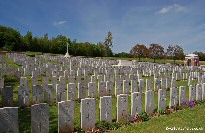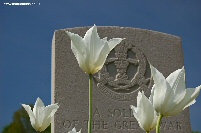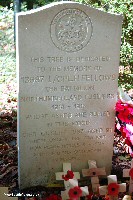Other sites around High Wood
The World War One Battlefields site is undergoing a major update, with pages being converted to a new, user-friendly mobile format. The updated pages can be found at Updated World War One Battlefields. Some pages such as this one remain in the original format pending update.

There is a lot to see at High Wood and in the area surrounding it; this page covers some of the villages near High Wood, including Bazentin-le-Petit, Martinpuich and Flatiron Copse cemetery. A separate page covers High Wood itself, with an account of the two months of fighting which were required for the British to finally take the wood. There is also a new page to cover Longueval and some of the cemeteries nearby including the large Caterpillar Valley Cemetery.
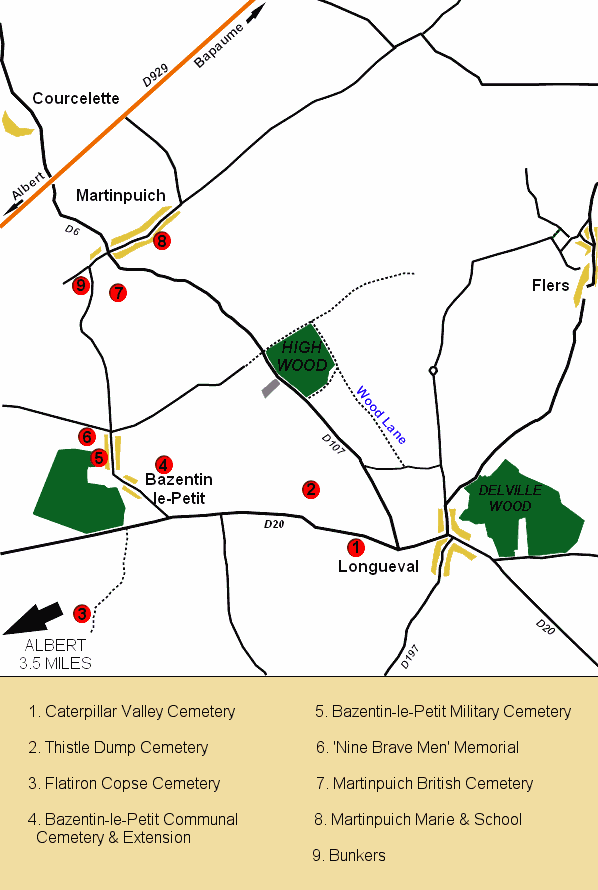
Map of High Wood and the area around
Flatiron Copse Cemetery
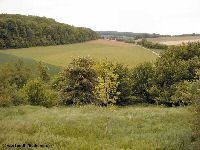
A view along Death Valley towards Flatiron Copse Cemetery
Actually listed on the CWGC website as Flatiron Copse Cemetery, Mametz, this Cemetery is less than two miles south-west of High Wood. It is located in a valley which was used as the main supply route during the attempts to advance the line at High Wood. The valley was protected from direct observation from the German lines by the topography of the land, and thousands of men and large numbers of supplies passed up this valley, often on the track that can be seen in the photograph above. Caterpillar Valley (see the section on the cemetery of the same name on the Longueval page) is just off to the right of the picture.
This valley was originally known to the troops as Happy Valley, and was taken during the advance of 14th of July, 1916 (the same day as the first unsuccessful attack at High Wood). Although the Germans could not directly observe the road and the valley, this was the only route that could be used, and they pounded it with shells. After a while it became known, therefore, as Death Valley. Today, the cemetery is reached by following a track which leads south from the D20 as this runs west towards Contalmaison.
Flatiron Copse Cemetery was started in late July 1916 and used until April of the following year. Flatiron Copse itself was a small area of woodland just to the north-east of where the cemetery now stands. This can still be seen across the track from the cemetery today. Inside the entrance to the right are special memorials to nine soldiers originally buried in Mametz Wood Cemetery whose graves were destroyed later on in the war. To the left of the entrance are a row of special memorials to men believed and known to be buried within Flatiron Copse Cemetery.
This is a fairly large cemetery, with 1,572 men buried or commemorated here. Of these, 420 are unknown. The large Cross of Sacrifice is locatd right at the back of the cemetery on a raised tier. One Victoria Cross winner is buried here: Corporal Edward Dwyer of the 1st East Surreys. He was 20 when he died in Spetember 1916, and so only ninteen when he won his VC at Hill 60 in April 1915. He repulsed a fierce German attack on his trench at Hill 60 bystanding on the parapet and hurling grenades at them.
The cemetery is probably unique, in that there are three sets of brothers buried here, who in each case died on the same day and are buried side by side. The pictures below shows the graves of Ernest and Herbert Philby of the Middlesex Regiment, who both died on the 21st of August, 1916, Henry and Thomas Hardwidge of the 15th Welsh Regiment, who died on the 11th of July 1916, and Arthur and Leonard Tregaskis, both Second Lieutenants in the 16th Welsh Regiment who both died on the 7th of July 1916.
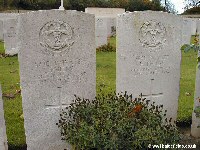
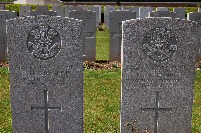
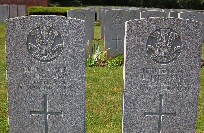
Graves of three sets of brothers who died on the same day next to each other at Flatiron Copse Cemetery
Harry Fellows Grave
This is located just within the northern side of Mametz Wood. From Flatiron Copse Cemetery, return up the track towards the D20, and turn left. After a short distance, the mass of Mametz Wood can be seen on the left side of the road. At the point where the wood comes near to the road there is a track leading to double metal gates. Following the track through these, after about 20 metres on the right is the grave of Harry Fellows.
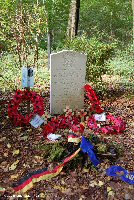
The grave of Harry Fellows in Mametz Wood
The spot is marked by a headstone which is quite similar to those seen in CWGC cemeteries, although the top is more curved. The stone records that in fact the ashes of Harry Fellows, of the 12th Northumberland Fusiliers, were buried here after he died in 1987, aged 91.
Harry wrote poetry, and on the stone are words from his poem 'Mametz Wood 1916 and 1984'. This descibed his experiences here during the war, when he asked whether with the "acrid stench of decay of mangled bodies lying around.....[and]......that German boy, his bowels astrew" the birds would ever sing here again.
Some more information on Harry Fellows can be found on the Western Front Association website.
Bazentin-le-Petit
This village was captured in the attacks of the 14th of July, 1916. The picture below shows this small and quiet village between the wars, and the view has not changed all that much in the modern picture that can be compared with it.
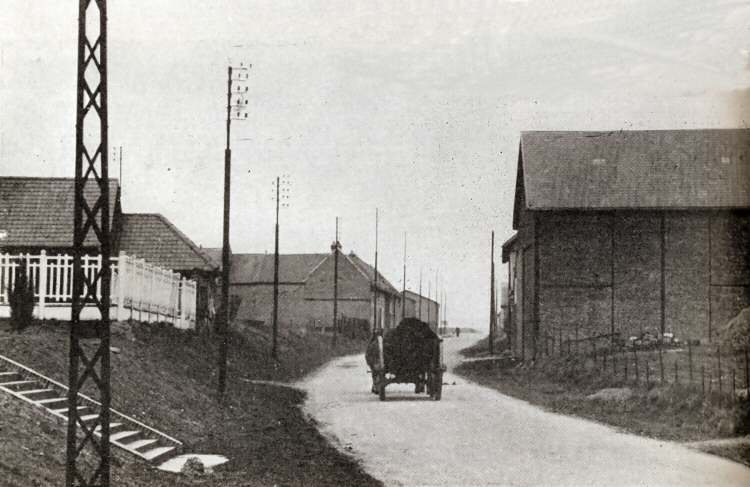
A view of Bazentin-le-Petit village between the Wars. Photo: G Watson
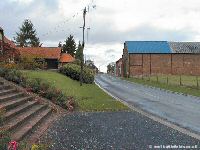
The same view in Bazentin-le-Petit today
Bazentin was 'adopted' by Ipswich after the war, and various gifts were sent by the town to help the villagers rebuild their farms and livelihoods. For example, in April 1922, Ipswich sent sixteen sacks of seed to the village.
Within Bazentin-le-Petit, heading uphill, a track leads off from the right of the road to Bazentin-le-Petit Communal Cemetery. This, the village civilian cemetery, contains the graves of two British soldiers. They are somewhat different in appearance to most CWGC graves on the Somme, as they are marked in outline full-length (see photo below).
The graves are of RSM W. Pearce of the 10th Loyal North Lancashires, and Lieutenant L. S. H. Griffin of the 10th Gloucesters. It has been speculated that these two bodies were recovered by French civilians after the War and brought back to the village Communal Cemetery for reburial. This may possibly be the case for RSM Pearce, but a letter from the War Office to Lieutenant Griffin's father sent on the 15th of November 1916 states that he is buried in Bazentin-le-Petit Communal Cemetery, where he still lies today. This letter goes on to say that the grave was "marked by a durable wooden cross with an inscription bearing full particulars".
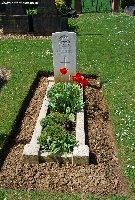
The grave of Lieutenant Leslie Griffin in Bazentin-le-Petit Communal Cemetery
With only two graves here, the date Lieutenant Griffin died struck me. I was born exactly fifty years to the day after this man lost his life on the 18th of August 1916, at the age of twenty. Many others died that same day - there were attacks on Guillemont as well as High Wood - but this coincidence prompted me to look a little further once I returned home. What I found certainly proves that behind every name on a Great War headstone lies a story.
From census information, I believed that he was Leslie Stewart Herbert Griffin, who (aged 5) was living at 16 Lodge Road, Croydon, when he was recorded by the Censor in 1901. His parents were Herbert, a banker's clerk, and Clara Griffin. They were well enough off at that time to be employing a servant. At the National Archives, the file on Leslie Griffin confirmed the identification was correct, and provided a great deal more information.
Leslie Griffin had been educated at St. Dunstan's College School and was living with his parents in Honor Oak Road, Forest Hill, working as a teabroker when the war broke out. He enlisted immediately, giving his age as nineteen years, eleven months, on the 8th of August 1914 as a Private soldier. He had been in the OTC at St. Dunstan's, and after enlisting originally served in No 1 Company the Honourable Artillery Company. In March 1915 he caught measles, and this was evidently a bad case as he was sent back to Britain on the 13th of March 1915. Shortly after this, on the 16th of April 1915 he applied for a commission, requesting the 10/Gloucesters as his unit of choice. He was listed in the London Gazette as transferred from the Reserve on the 10th of May 1915.
When he was killed on the 18th of August 1916, he was unmarried, and left no will. He had been appointed a temporary Lieutenant, effective from the 4th of June, 1916 (but published in the London Gazette on the 7th of August, just 11 days before he died). After he was killed, and his parents had been informed, his father, Herbert Edward Griffin, wrote to the War Office in October 1916 to point out that Leslie's death certificate had been incorrectly issued with his rank as Second Lieutenant. The death certificate was reissued showing his correct rank, and a copy on flimsy paper of this bald, typed document exists in his file at Kew.
How must his parents have suffered on hearing of his death? It is almost impossible to imagine, but he was "Mentioned in Despatches" in the London Gazette on the 4th of January 1917. Two days later, his grieving mother, Clara, wrote an angry letter on black-bordered notepaper to the War Office. She believed that Leslie should have been awarded a decoration, as "he was commended for bringing in a wounded man under considerable fire......on June 16th near Loos". (There are no details in the London Gazette for "Mentioned in Despatches", so it is not clear if the "mention" was for the incident near Loos).
However, Clara Griffin evidently felt that being Mentioned in Despatches was not enough. She asked the War Office to communicate direct with the Commander-in-Chief (Douglas Haig). Her grieving at her loss is obvious, as she wrote "Must mothers give their sons and gallant deeds go unrecorded because their sons die in the performance of their duty.......is 'glory' the only record for the dead who have fallen on the field?". The anguish this mother felt is palpable in her letter.
A typed reply was sent by the War Office four days later, informing her that there was no record at the War Office of any award being made. The letter continued that there was no objection to her taking up her concern with the Military Secretary at GHQ in France, but a final handwritten statement added at the end of the letter adds "but I fear no good will result" .
Lieutenant Leslie Griffin was killed in action on Friday the 18th of August 1916, serving with D Company of the 10/Gloucesters, in an attack mounted by the 1st Division just north of High Wood. The files cannot say a great deal about the man himself, but behind these simple facts lies the grim reality of war, the suffering of his parents and a life cut short at the age of just twenty.
To the left of the Communal Cemetery is Bazentin-le-Petit Communal Cemetery Extension. This is a wartime cemetery, started after the capture of the village and used until December 1916, when it would have contained around 135 burials. However the 'headstones' around the walls of the cemetery are in fact special memorials to private soldiers, the position of whose graves had been lost. These can be seen to the left side of the right hand picture below. There are irregularly spaced graves within the cemetery, and after the Armistice another 50 graves were brought into the cemetery. Thre gravs of unknown soldiers are located on the small upper tier where the Cross of Sacrifice stands. Very near these cemeteries was a quarry where a Dressing Station was located in July 1916. The poet and author Robert Graves was brought after being wounded on the 20th of July on his way up to High Wood.
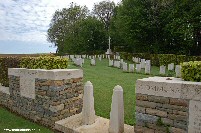
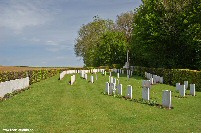
Bazentin-le-Petit Communal Cemetery Extension
Further up the village street in Bazentin-le-Petit, a grass track to the left leads to Bazentin-le-Petit Military Cemetery. By the side of the grass track, silent pickets hold up the wire fence to right. They can also be seen supporting other fences within the village.
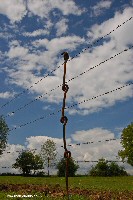
Silent pickets by the track leading to Bazentin-le-Petit Military Cemetery
An Advanced Dressing Station was located here during the Somme offensives, and the cemetery was used from July 1916 until around May the following year. The Cemetery contains 182 burials, all but 15 of which are identified. There are some apparent spaces in the rows, which are the result of German graves which were here, but later removed. The Cross of Sacrifice is set in triangular section in one corner of the cemetery, and there is one special memorial right at he front of the cemetery by itself.
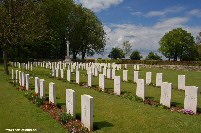
Bazentin-le-Petit Military Cemetery
One of the interesting graves here is that of Captain Harold Teague, a member of the 11th Battalion of the Australian Infantry. He died on Valentines day, 1917, and his grave has not only the usual CWGC headstone, but also a smaller headstone beside it, shown in the pictures below. A wooden cross may once have been on the 'pin' that can be seen on the top of the smaller stone.
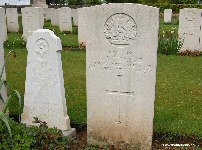

The grave and memorial to Captain Teague, Bazentin-le-Petit Military Cemetery
There are a number of similar instances of these 'unofficial memorial stones' on the Western Front, but they are fairly rare.
Returning to the road, and continuing uphill leads to a bend to the left. Just after this is the 'Nine Brave Men' memorial.
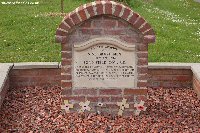
The'Nine Brave Men' memorial to the north of Bazentin-le-Petit
This memorial was originally made with bricks from the village, and was renovated in 1989; it commemorates men from the 82nd Field Company, Royal Engineers, who were killed on the 29th of July, 1916. Men were sent on wiring parties to Bazentin, with three killed one night and another six the next day. Another 19 were wounded on the second occasion, from a party of 40.
Martinpuich
Martinpuich village is about a mile north-west of High Wood,and like the wood was captured on September the 15th, 1916. Troops of the 15th (Scottish) Division took the village. This location is now close to the main D929 Albert-Bapaume road, and Courcelette village lies on the other side of that road.
If you are travelling from High Wood towards Martinpuich, then before the village, located down a track leading off to the left of the D107 road is Martinpuich British Cemetery. This was started in November 1916, and then used until June of the following year, and again in the summer of 1918. There are 115 burials here; including nine unidentified men and special memorials to four men whose graves were destroyed by shellfire located at the front of the cemetery. The graves are well spaced, and include a number of graves of men who died before the cemetery was started.
The explanation behind this is that four soldiers of the 1st Dorsets, who were killed in March 1916 in a raid about four miles from here near la Boiselle, were originally were buried by the Germans in the civilian cemetery near here after they died. Thier graves were only discovered in 1931. They, and the remains of another six undentified soldiers, were moved to the Military Cemetery and reburied in Row A, although several lie in what is designated in CWGC records as 'Collective Grave. A. 19-24.' The plans of the Cemetery only show up to A16, reflecting the original burials. The plan of the cemetery also shows a 'Land Tablet' located within the cemetery towards the back right; this may have been a predecessor of the stone now inlaid within the wall of the cemetery (and in others) relating to the land being ceded in perpetuity.
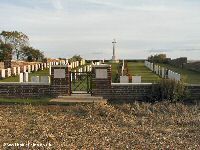
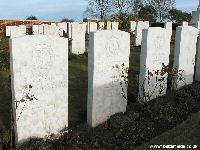
Martinpuch British Cemetery (left), and graves of Dorset men originally buried by the Germans (right)
Returning to the road, one next reaches the village itself. Graham Hutchison, who published an early guide for visitors to the Western Front titled Pilgrimage in 1934, fought in this area. He states "To Martinpuich, the City of London gave its school and Mairie, built in solid stone, with a wide forecourt which serves as a playground, and to which entry is obtained through a noble archway upon which are inscribed the battle honours of the London Division." The Marie/School, playground with loggia and the memorial gateway can still be seen in the village today, and are shown in the pictures below. The architect of the gateway, and of the original memorial to the 47th Division at High Wood, was W.G. Newton, who himself won a Military Cross at High Wood during the war.
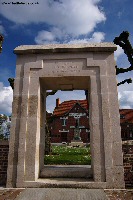
The 47th Division gateway in front of the Martinpuich school
The gateway here was unveiled on the 13th of September, 1925, by Lieutenant-General Sir George Gorringe, who commanded the 47th Division after Charles Barter. The village war memorial stands in front of the school, and this was unveiled on the same day by the French.
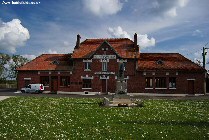
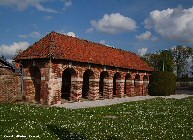
The school/Marie and the loggia funded by the 47th (London) Division at Martinpuich
On a road to the south of the village is a large German bunker. It now stands in a peaceful field, of main interest to the cows who roam here.
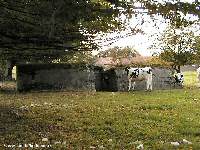
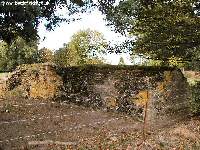
Bunker near Martinpuich, now home to cows
Sources/Acknowledgements
Commonwealth War Graves Commission website
Robert Graves: Goodbye to All That
Major & Mrs. Holt: Battlefield Guide to the Somme
Lt.-Col. Graham Hutchison: Pilgrimage
Lost Generation 1418 Forum for help in locating Lt. Griffin's MiD citation
Chris McCarthy: The Somme - the day by day account
Martin & Mary Middlebrook: Somme Battlefields
National Archives: Files on Lt. Griffin
Terry Norman: The Hell They Called High Wood
Paul Reed: Walking the Somme (plus other information provided)
Somme 1916 website

